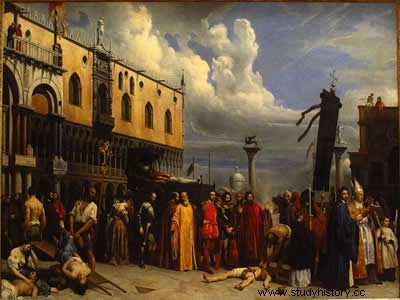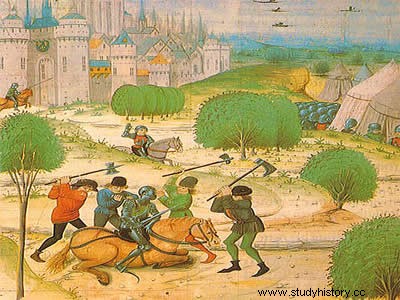(UEL-PR) “[...] the demographic increase, which took place from the 11th to the 16th century, allowed the multiplication of the increasingly parasitic nobility. Their consumption habits became more demanding and larger, which determined a need for an increasingly higher income. There follows, therefore, a super-exploitation of the work of the servants, requiring them to work longer [...]”.
The text describes one of the causes, in Europe, of:
- formation of the Asian mode of production.
- consolidation of enlightened despotism.
- decay of commerce that produced ruralization.
- crisis that led to the disintegration of feudalism.
- prosperity that sparked the industrialization process.
(UFRGS) Read the text below:
“So great was the number of dead that, when the coffins were scarce, the corpses were placed on simple boards. Not one coffin received two or three dead simultaneously. Nor did it happen once that only a wife and husband, or two and three brothers, or father and children, were buried in the same coffin [...].
To bury the multitude of bodies that were heading to any church, every day, almost every hour, the already sacred land was not enough; and even less would it suffice if it were desired to give each body its own place, according to the ancient custom. For this reason, churches began to be built in cemeteries, because all the places were full, even if some were very large; The bodies that arrived were placed in these churches, by the hundreds; and they were piled up like the goods of ships [...].”
BOCCACCIO, Giovanni. Decameron . São Paulo:April, 1981.
The testimony of the Italian writer Boccaccio makes reference to the advent of the Black Death in Western Europe, which accelerated the crisis of the feudal system of the 14th and 15th centuries.
Choose, among the alternatives below, the factor to which this crisis can be related.
- In the 14th and 15th centuries, the European economy became predominantly urban, which led to a lack of rural workers for agricultural production. Without good food, the population was more prone to disease.
- Demographic growth asserted itself throughout the Late Middle Ages to a point where the production of the feudal system was no longer able to feed the population that was weakened.
- The production techniques were very developed for the time, to the point of causing an overproduction that generated an imbalance in the system.
- Serfdom, established as the predominant form of work in Western Europe from the 15th century onwards, weakened the population and led to endemic mortality.
- As a result of the mortality caused by the Black Death, the nobles enacted laws to help the peasant population.
The crisis of feudalism in Western Europe marked the end of the Middle Ages. Among the causes that are attributed to the crisis, no we can include:
- The Hundred Years War.
- To Jacquerie.
- The Industrial Revolution.
- The Black Death.
- Unhealthy cities.
Analyze the statements below about the crisis of feudalism:
I - Peasants responded to the increased obligations imposed by the lords with a wave of violent protests that took place throughout the 14th century. The so-called jacqueries were a series of peasant revolts that developed in different parts of Europe.
II - In the 14th century, the Black Death spread across Europe, causing a massive wave of deaths that claimed approximately one-third of the continent's population. In the 15th century, the European population reached 35 million inhabitants.
III - The lack of available manpower resulting from the Black Death reinforced the rigidity previously observed in the relations between lords and serfs. Fearing to lose their serfs, the feudal lords created new obligations to strengthen the peasants' bond with the land.
Tick the alternatives:
- only if statements I and II are incorrect.
- only if statements I and III are incorrect.
- only if statements II and III are incorrect.
- only if all statements are correct.
- only if all statements are incorrect.
Match the numbered images to the factors related to the crisis of feudalism, referred to by letters.

Image Credit:Louvre Museum.

Image Credit:Center Historique des Archives Nationales

- Hundred Years War
- Jacquerie
- Black Plague
The Alternative that correctly indicates the correlation is:
- 1-a; 2-b; 3-c.
- 1-c; 2-a; 3-b.
- 1-b; 2-c; 3-a.
- 1-c; 2-b; 3-a.
Letter D .
The Asian mode of production did not refer to the form of social organization in Europe, as stated in “a” . The enlightened despotism referred to in “b” was later than this period of European history. The 14th century crisis was more linked to the growth of trade and not to ruralization as stated in “c” . The accumulation of capital that generated industrialization did not come so much from the countryside, but from the cities and commerce, making the letter “e” incorrect. .
question 2Letter B .
The European economy was not yet urbanized, as explained in A . Production techniques were poorly developed, which invalidates the C alternative . Serfdom was in decline in the 15th century, contrary to what is written in D . The nobles did not seek to help the peasants after the Black Death, on the contrary, they sought to exploit them even more, information that invalidates the alternative E.
question 3Letter C .
The Industrial Revolution was not the cause of the 14th century crisis, as it occurred after that period, in the 18th century.
question 4Letter D .
question 5Letter B.
